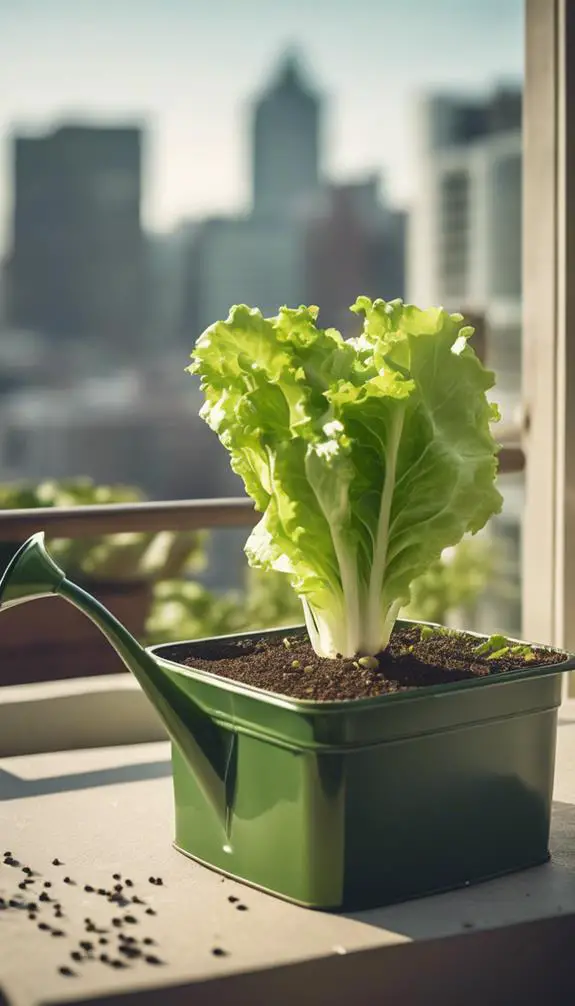You're probably wondering how to grow crisp, fresh lettuce in the comfort of your own home, without the hassle of soil. Growing lettuce in water is a great way to do just that, and it's easier than you think. By selecting the right variety, preparing your seeds, and setting up a simple water system, you'll be on your way to harvesting fresh lettuce in no time. But that's just the beginning – there are a few vital steps you'll need to take to guarantee your lettuce flourishes in its new aquatic environment.
Summary
- Select a lettuce variety that thrives in hydroponic conditions, such as loose-leaf or romaine, for optimal growth.
- Prepare seeds for germination through seed treatment, such as soaking in a solution, for uniform germination.
- Use a food-grade container with a high-quality water pump and aeration system to maintain peak water quality and circulation.
- Provide lettuce with 12-14 hours of balanced spectrum light per day, with optimal intensity and temperature control, for healthy growth.
- Fertilize lettuce regularly with water-soluble fertilizers and prune it to shape for better growth, encouraging the plant to focus energy on producing more leaves.
Choosing the Right Lettuce Variety
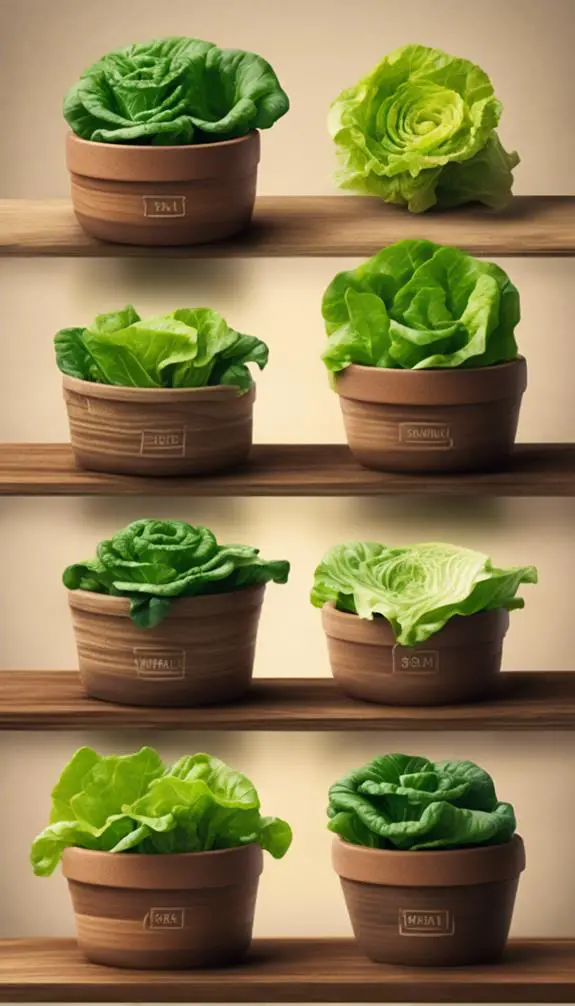
When it comes to growing lettuce in water, selecting the right variety is essential for ideal results.
You'll want to choose a type that thrives in hydroponic conditions. Consider your lettuce preferences: do you like crisp, crunchy leaves or soft, delicate ones?
Leaf textures vary greatly between varieties, and some perform better in water than others. For instance, loose-leaf lettuce and romaine are great options, as they've a more delicate texture and can absorb nutrients efficiently.
On the other hand, crisphead lettuce may not fare as well, as it requires more support and has a denser leaf structure.
Gathering Essential Materials
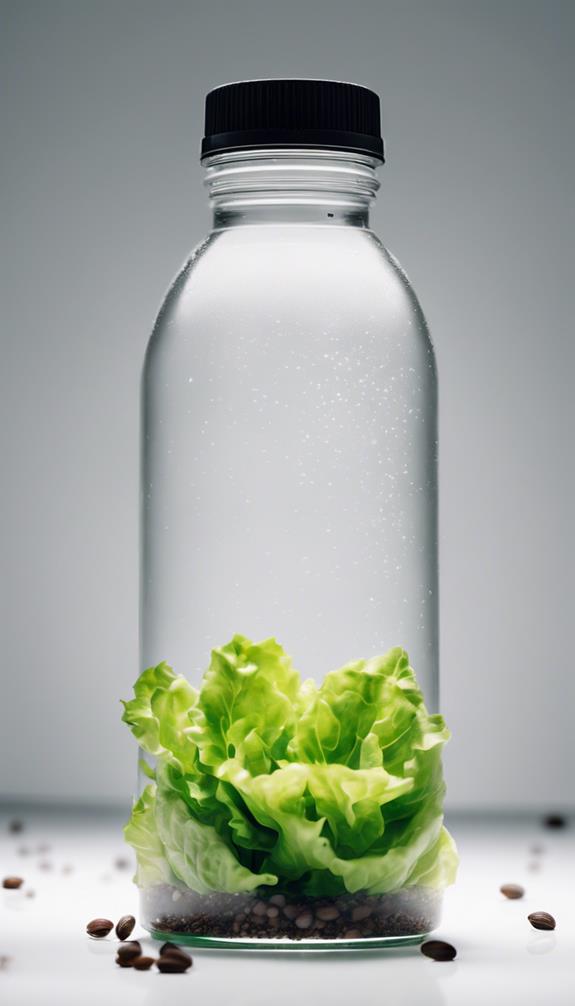
Set up your hydroponic lettuce garden by gathering the essential materials you'll need to get started.
First, you'll need a container that's specifically designed for hydroponic growing. Consider a food-grade container that's resistant to corrosion and can hold a minimum of 5 gallons of water. Pay attention to the material's water quality compatibility to guarantee it won't contaminate your system.
Next, you'll need a high-quality water pump and aeration system to maintain peak water quality and circulation.
Additionally, you'll need a trellis or netting to support the lettuce plants as they grow.
Don't forget to grab a pH test kit to monitor the water's acidity levels.
Setting Up the Water System
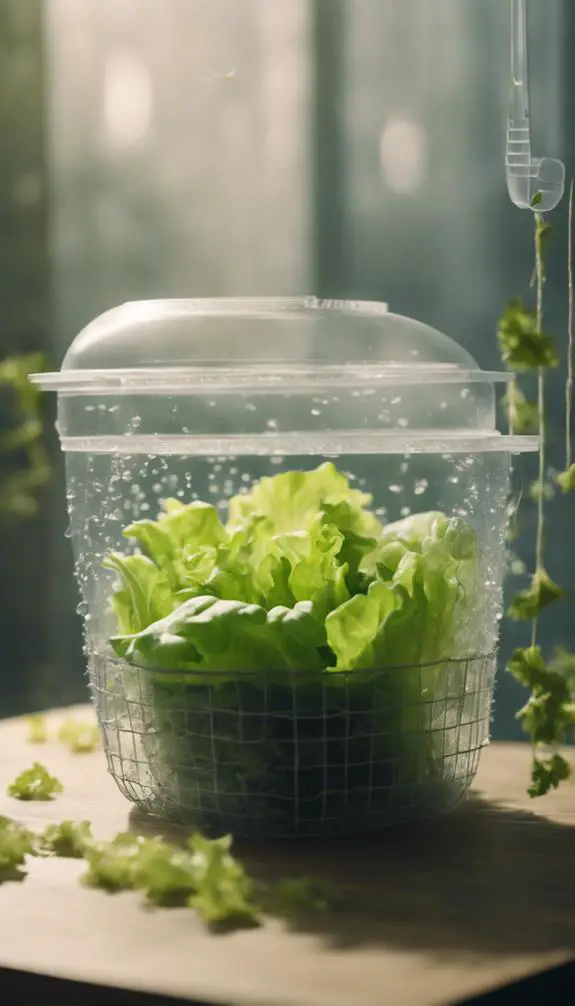
You'll begin constructing your hydroponic lettuce garden's water system by connecting the water pump to the aeration system. This connection enables efficient water circulation, a vital aspect of hydroponic benefits.
Next, attach the water reservoir to the pump, ensuring a secure and watertight seal. The reservoir will hold the nutrient-rich solution that will feed your lettuce plants.
Connect the solution tubes to the plant baskets, allowing the water to circulate and provide essential nutrients to the roots. Finally, add an air stone to the reservoir to increase oxygen levels, promoting healthy plant growth.
With your water system set up, you're ready to move on to the next step in growing crisp, delicious lettuce in water.
Preparing the Lettuce Seeds
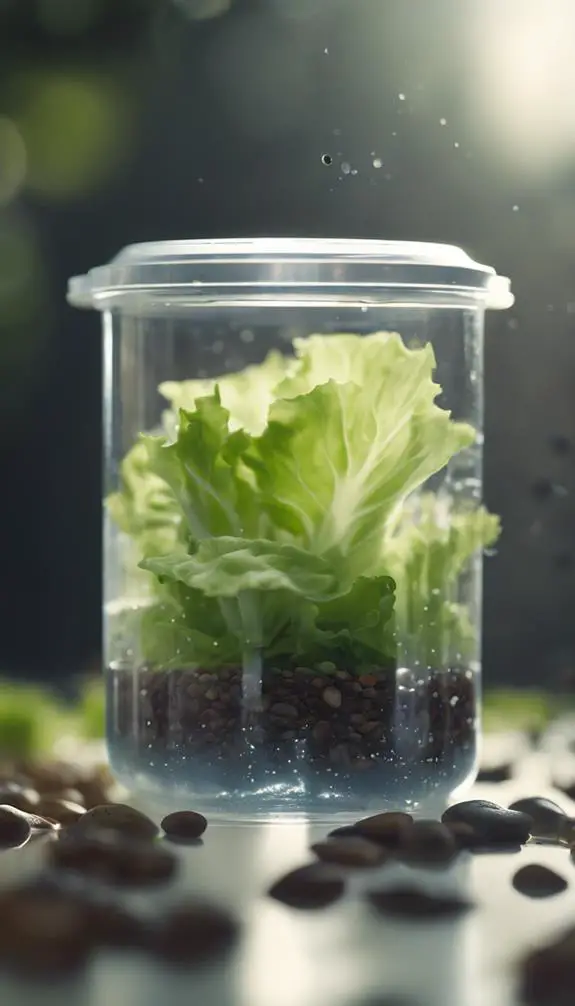
The seeds you've chosen for your hydroponic lettuce garden require preparation to guarantee ideal germination and growth.
Start by selecting high-quality seeds specifically bred for hydroponic systems. Verify they're fresh and suitable for your desired lettuce variety.
Next, prepare the seeds for germination through seed treatment. This involves soaking the seeds in a solution to stimulate germination and enhance seedling growth.
You can use a commercial seed starter or a DIY mix of water and hydrogen peroxide. Soak the seeds for 12-24 hours, then rinse them thoroughly.
This treatment will help break down the seed coat and encourage uniform germination.
After treatment, your seeds are ready for planting in your hydroponic system.
Planting the Seeds in Water

With your seeds properly treated, it's time to introduce them to their new hydroponic home.
You'll need a clean container filled with water that's changed regularly to maintain clarity. The ideal water temperature for lettuce germination is between 65°F and 75°F.
Suspend a net basket or a seed tray above the waterline to prevent the seeds from washing away. Gently place the seeds in the basket, ensuring even spacing for peak growth.
Use a seed selection that's specifically bred for hydroponic systems, as they'll produce better results. Once the seeds are planted, cover the container to maintain humidity and prevent light from penetrating the water.
You're now ready to provide the necessary conditions for germination.
Providing Optimal Lighting
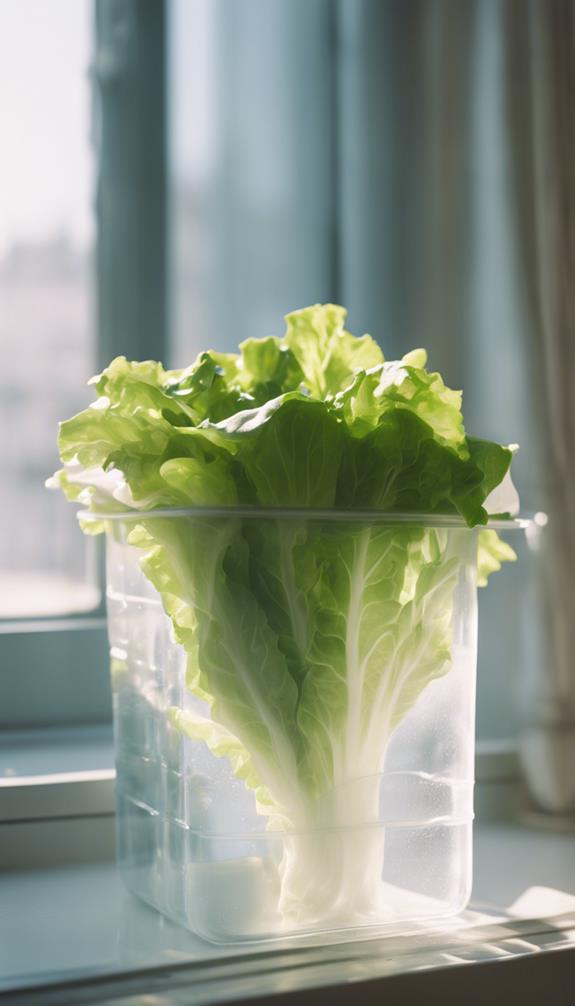
Proper lighting is crucial for lettuce growth, and its placement will substantially impact the development of your crop.
You'll want to provide your lettuce with a light intensity of around 12-14 hours of light per day, with a prime intensity of 20-40 umol/s.
As for the color spectrum, lettuce responds best to a balanced spectrum with a mix of blue, red, and green light.
Aim for a spectrum that includes 40-50% blue light, 30-40% red light, and 10-20% green light.
This will promote healthy leaf growth and prevent stretching.
Maintaining Water Temperature
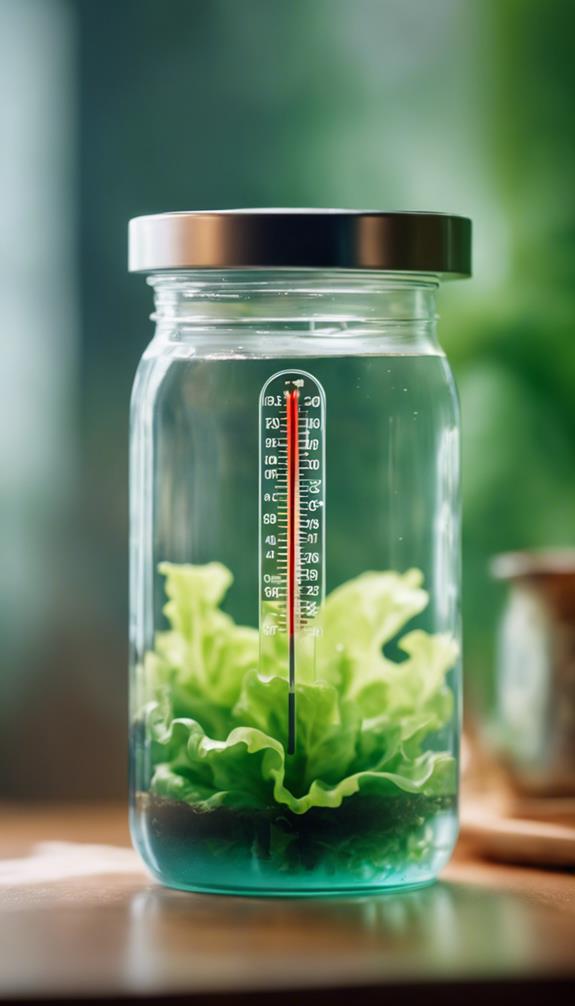
You'll need to maintain a consistent water temperature between 65°F to 75°F (18°C to 24°C) for peak lettuce growth, as temperatures outside this range can hinder root development and leaf quality.
Fluctuations in water temperature can also stress your lettuce, making it more susceptible to disease and pests. By keeping the water temperature within the ideal range, you'll create a stable environment that promotes healthy growth and maximizes yields.
Ideal Water Temperature
As lettuce roots absorb water, they're sensitive to temperature fluctuations, which affect their growth rate and overall health.
When it comes to ideal water temperature, you're aiming for a range between 65°F and 75°F (18°C and 24°C). This allows for peak growth, while minimizing thermal stress.
Water clarity also plays a vital role, as clear water promotes healthy root development. Avoid temperatures above 80°F (27°C), as this can lead to reduced growth and increased susceptibility to disease.
Water Temp Fluctuations
During the growth cycle of your lettuce plants, water temperature fluctuations can occur, and maintaining ideal circumstances is vital to minimize these changes and guarantee prime growth conditions.
You'll want to monitor water temperature closely, as sudden drops or spikes can cause water stress, leading to reduced growth or even plant death. Temperature fluctuations can be caused by various factors, including changes in room temperature, equipment malfunction, or inadequate insulation.
To mitigate this, consider using a temperature-controlled water tank or a thermoregulatory system. By maintaining a consistent water temperature between 68°F to 72°F (20°C to 22°C), you'll create a perfect environment for your lettuce plants to thrive.
Monitoring Water Quality
Since lettuce roots are constantly absorbing water and nutrients, monitoring water quality is essential to prevent contamination and guarantee healthy plant growth.
You'll need to test the water regularly to verify it's free from contaminants and maintain ideal conditions. Conduct water testing to measure parameters like pH, ammonia, and nitrite levels.
pH balancing is pivotal, as lettuce prefers a slightly acidic to neutral environment (pH 6.0-7.0). If the pH is too high or low, adjust it using pH adjusters or by replacing some of the water.
Regular monitoring will help you identify any issues early on and make necessary adjustments to promote healthy growth and prevent root rot.
Fertilizing the Lettuce
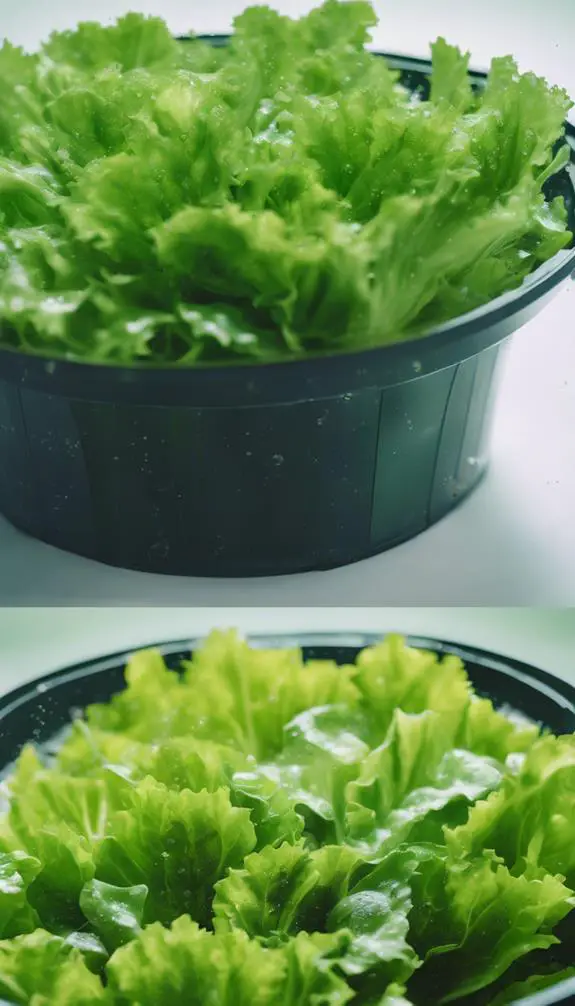
You're likely wondering how to provide your lettuce with the necessary nutrients for ideal growth.
When it comes to fertilizing your hydroponic lettuce, you'll want to use water-soluble fertilizers that are specifically formulated for hydroponic systems. These liquid nutrients are easily absorbed by the roots, promoting healthy growth and development.
Look for a balanced fertilizer that contains nitrogen, phosphorus, and potassium, as well as micronutrients like iron and calcium. Follow the manufacturer's instructions for application rates, as over-fertilization can be detrimental to your crop.
With the right fertilizer, you'll be on your way to growing crisp, delicious lettuce in no time.
Pruning and Training
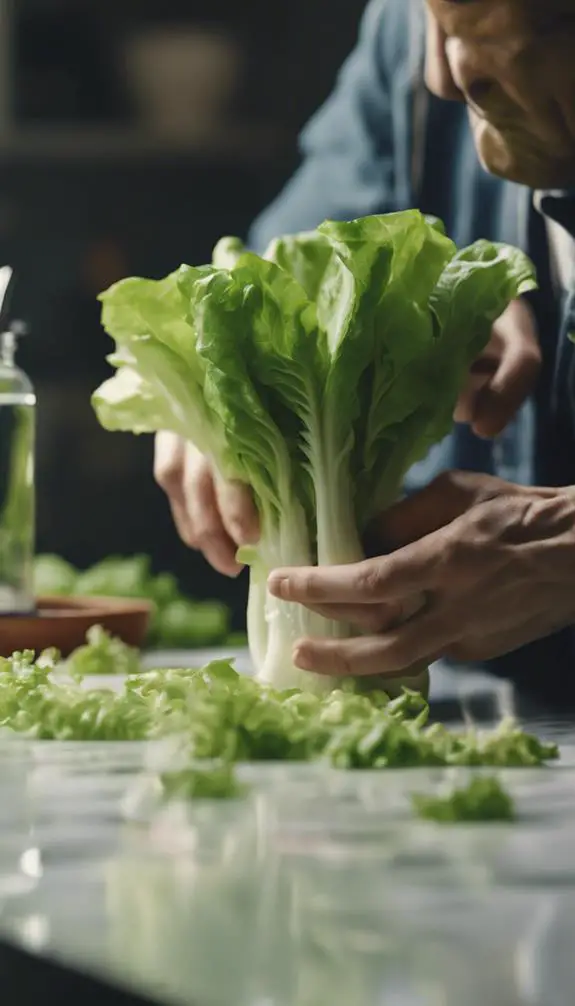
You'll want to prune your lettuce to shape it for better growth, as this encourages the plant to focus its energy on producing more leaves.
By trimming back the longest stems, you'll promote bushy development and prevent the lettuce from becoming leggy.
Regular pruning will also help you harvest more leaves in the long run.
Shape for Better Growth
Your lettuce plants' shape plays a crucial role in their growth and development.
By shaping your plants, you can optimize their leaf structure to maximize water uptake and photosynthesis. To achieve this, gently guide the stems to grow outward and upward, creating an open water architecture that allows for efficient water circulation.
This will guarantee that each leaf receives sufficient light and nutrients. As you shape your plants, make sure to maintain a balanced canopy to prevent overcrowding and promote air circulation.
Encourage Bushy Development
Pruning and training your lettuce plants is essential to encourage bushy development and maximize yields.
You'll want to trim off any weak or spindly growth, making room for stronger stems to thrive. This process promotes lettuce density, allowing more leaves to grow in a smaller space.
As you prune, focus on the center of the plant, removing any weak or damaged leaves to direct energy towards healthy growth. This will stimulate leaf expansion, resulting in larger, more robust leaves.
Regular pruning also encourages the plant to produce more lateral growth, increasing overall yields. By training your lettuce plants, you'll be rewarded with a lush, bushy harvest in no time.
Common Problems to Watch
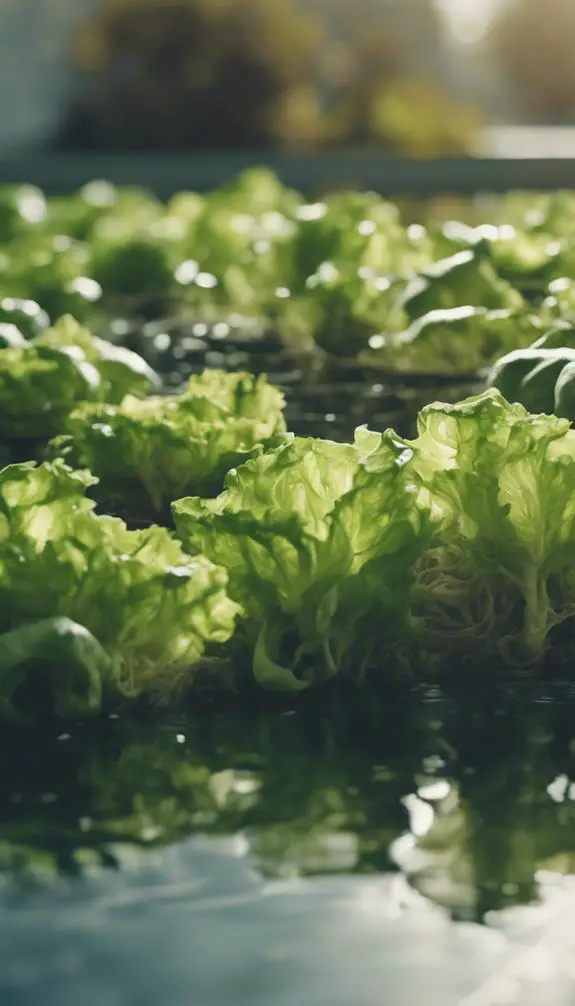
Growing lettuce in water can be a relatively low-maintenance process, but it's not without its challenges.
You'll need to keep an eye out for waterborne pests like aphids, whiteflies, and spider mites that can infest your lettuce. These pests can spread quickly, so it's vital to monitor your plants closely and take action at the first sign of trouble.
Another common issue is root bound systems, where the roots outgrow their container. This can lead to stunted growth and reduced yields.
Make sure to transplant your lettuce into larger containers or a hydroponic system as needed to prevent root bound. By being proactive and addressing these common problems, you can guarantee a healthy and thriving lettuce crop.
Harvesting Fresh Lettuce

With your lettuce plants thriving, it's time to reap the rewards of your labor.
Harvesting fresh lettuce is an art that requires precision and care. Using scissors or pinchers, gently snip or pinch off the largest leaves at the base of the stem, leaving about an inch of stem intact.
This allows the plant to continue growing and producing new leafy delights. Harvest in the morning, when leaves are at their peak fresh crispness, to guarantee prime flavor and texture.
Avoid pulling the entire plant out of the water, as this can cause shock and reduce future growth. By harvesting correctly, you'll be enjoying a continuous supply of crisp, fresh lettuce.
Tips for Continuous Growth

You'll want to establish a water change schedule to prevent nutrient depletion and bacterial growth.
Next, you'll need to maintain a delicate nutrient balance to promote healthy leaf development.
Water Change Schedule
Since lettuce roots absorb nutrients and oxygen from the water, this is vital to maintain superior water quality to promote continuous growth.
You'll need to establish a water change schedule to guarantee ideal conditions. Aim for a water refresh rate of 25-50% every 3-5 days, depending on the water clarity and temperature.
Perform regular water clarity checks to determine when a change is needed. Look for signs of cloudiness, algae growth, or a decrease in oxygen levels. If you notice any of these indicators, it's time to refresh the water.
Nutrient Balance Tips
Maintaining a delicate balance of nutrients is crucial for promoting continuous growth in your hydroponic lettuce.
You'll need to monitor and adjust pH levels, ensuring they stay between 5.5 and 6.5. This narrow range allows for peak nutrient uptake.
Next, focus on achieving the ideal nutrient ratios. Aim for a balanced mix of nitrogen, phosphorus, and potassium (NPK) with a ratio of 2:1:1 or 3:2:1.
Regularly test your nutrient solution to avoid deficiencies or excesses, which can hinder growth. By maintaining this balance, you'll create an environment that fosters healthy, thriving lettuce.
Prune for Regrowth
How do you guarantee your hydroponic lettuce continues to thrive once it's reached maturity?
Pruning is key. You'll need to trim your lettuce to encourage regrowth and maintain ideal leaf density.
Cutting patterns are vital – aim to remove about one-third of the leaves, leaving the central stem intact. This will redirect the plant's energy towards producing new growth.
Make clean cuts just above a node, using scissors or clippers to prevent tearing the leaves.
Prune your lettuce regularly to promote continuous growth and prevent it from flowering.
FAQs
Can I Use Tap Water to Grow Lettuce in Water?
When growing lettuce in water, you should avoid using tap water, as it may contain impurities affecting water quality. Instead, opt for filtered water to guarantee ideal circumstances, promoting healthy growth and minimizing contamination risks.
How Often Should I Change the Water in My System?
You'll want to change the water every 7-10 days to maintain ideal water quality, as stagnant water can harbor bacteria and compromise your system's efficacy; consider implementing a water purification system to extend water refresh cycles.
Will Pests Be a Problem in a Water-Based Lettuce System?
You'll need to monitor your system closely, as standing water can attract pests; Mosquito breeding and Algae blooms are potential issues, but implementing proper filtration and aeration can minimize these risks and guarantee a healthy, pest-free harvest.
Can I Grow Lettuce in Water Indoors Without Natural Light?
You can cultivate lettuce indoors without natural light by replicating an ideal indoor climate, employing artificial lighting with a spectrum and intensity tailored to lettuce growth, and maintaining precise temperature and humidity controls.
Is It Safe to Eat Lettuce Grown in Water With Added Fertilizers?
When consuming hydroponically grown lettuce with added fertilizers, you're right to question food safety. Guarantee the fertilizers are organic and free of chemical residues to avoid potential health risks, as even trace amounts can contaminate your harvest.
Conclusion
You've successfully grown lettuce in water! Now, maintain the ideal conditions and fertilize regularly to promote continuous growth. Monitor pH levels, water temperature, and light exposure to guarantee a healthy harvest. With proper care, you'll enjoy fresh, crisp lettuce leaves all year round.




